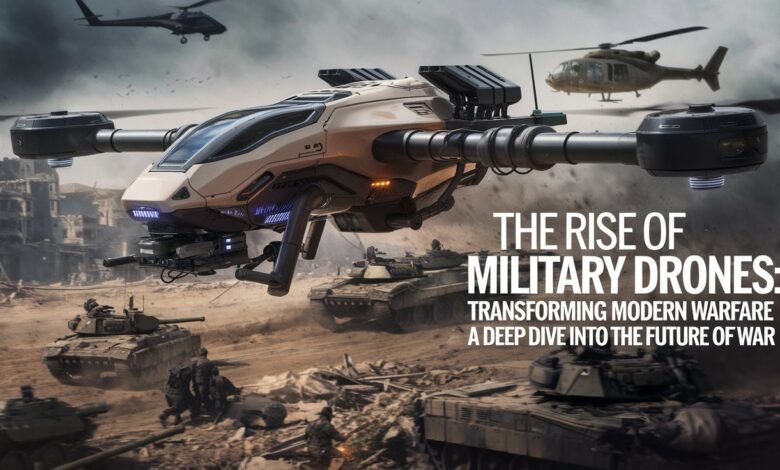
Introduction
In this way, drones have rapidly become the cornerstone of military operations around the world, revolutionizing how wars are prosecuted and how military strategies are designed. What started in humble beginnings as a means for intelligence gathering, highly refined technology today allows drones to accomplish these core tasks of reconnaissance, precision strikes, and autonomous decision-making with aplomb. The following article outlines the expanding nature of military drone operations, discusses key technological advances, and explains the meaning of this high-tech form of warfare on the implications for global security and military ethics.
The Evolution of Military Drones
Unmanned flying vehicles, or UAVs, entered military service in the early 2000s, mainly for use in surveillance and intelligence. For the very first time, the armed forces had a strategic advantage in being able to acquire real-time battlefield imagery without risking the lives of pilots. Workhorses like the RQ-4 Global Hawk and MQ-9 Reaper have become synonymous with military uses for drones, given their capability to conduct extremely long-duration surveillance and precision strikes.
However, soon enough, drone technology outgrew the bounds of observation tools only. They started playing a very important role in combat operations with precision targeting, especially in counterterrorism missions across the Middle East. The U.S. military used drones widely for precision strikes that allowed them to strike against high-value targets with minimal damage to any collateral target and at limited risk to military personnel.
Key Uses of Military Drones
1. Intelligence, Surveillance, and Reconnaissance (ISR)
Core usages of drones in the military include surveillance. Fitted with high-resolution cameras, as well as advanced sensors, drones have the ability to survey large areas, gather critical intelligence, and monitor enemy movements in real time. In fact, this capability enhances the situational awareness of the military and thus helps commanders make more informed decisions on the battlefield.
The U.S. RQ-4 Global Hawk is a prime example of a surveillance drone. These provide very important intelligence in high-altitude military planning, availing a bird’s eye view of critical regions without requiring manned missions.
2. Precision Strikes
Drones can also be fitted with guided munitions, like the MQ-9 Reaper, to carry out precision strikes on enemy forces and infrastructure. This has proved to be priceless in missions where precision makes all the difference in reducing civilian casualties or damage to key infrastructures. In Afghanistan and Iraq, militants’ leaders and insurgents were often targeted by deploying drones; hence, unmanned warfare was adopted.
This shift not only has bettered battlefield effectiveness but also allowed for the continuous monitoring and engagement of targets that with manned missions would have been impossible to visualize.
3. Autonomous Warfare and AI Integration
As AI continues to develop, military drones are gaining unprecedented levels of autonomy. From executing activities that require little direct human interaction through the use of AI-enabled drones, processing battlefield data in real time, and even making independent decisions in combat, this developing capability is the path towards allowing drones to assume more risky missions, such as identifying and neutralizing threats without direct control.
With the integration of AI, the human role is likely to shift away from actual piloting in drone warfare to high-level oversight and strategic decision-making. This decreases not only the need for human interference but allows for complex and efficient drone operations.
4. Swarm Technology
The other major development in the realm of drone warfare is swarm technology. These are drones working in a configuration to accomplish a particular attack, reconnaissance, or defense mission. A swarm of drones could quite conceivably carry out such an advanced operation like degrading enemy air defenses or wide-area surveillance more effectively than a single large drone.
Swarm technology could revolutionize battlefield tactics, providing military forces with flexibility and coordination never available in combat, particularly in theatres where hostile forces have developed anti-aircraft systems with advanced capability.
5. Stealth, Range, and Endurance
Modern military drones are in a race to evolve on equal grounds regarding stealth and endurance. The future drones will also be capable of penetrating the heavily defended territory, conducting operations over a long range, and not being detected due to advanced propulsion systems and low-observable technology. Longer flight ranges and higher endurance enable the drone to travel over longer distances, minimizing the logistics load from military forces and concurrently enhancing effectiveness at operations.
Furthermore, increases in energy harvesting-as has been demonstrated with solar-powered drones-can also serve to extend the duration of operation for such systems and thereby make it potentially a very useful instrument in long, dragged-out situations of conflict.
Legal and Ethical Considerations
Ethics and legal questions arise more and more, as war fought by drones becomes more sophisticated and autonomous. While drones attain much in precision, reducing risks to human soldiers of one’s own side, accountability about combat procedures has raised concern. Civilian casualties from drone strikes have also turned an issue of controversy, especially in those conflict areas where militant targets are usually enveloped by the civilian population.
Equally of concern is decision-making in lethal operations by autonomous means. As drones become more autonomous, the line of where responsibility for life-or-death decisions—taken by human operators or algorithms—becomes increasingly blurred. Given their increasing usage in multi-dimensional conflict theaters such as Ukraine, there are, in fact, efforts underway to develop more direct legal frameworks that address these concerns.
Global Adoption of Drones
Where military drones are concerned, while the United States is still well ahead, several other nations are rapidly closing the gap. Advanced drones, virtually matching the capability of the systems fielded by the United States, are currently under development by China and Russia, while Israel too has emerged as a major player in UAV technology with systems like the Heron and Eitan. Greater access to drone technology resulted in non-state actors, terrorist organizations included, also using drones for espionage and combat missions.
This is the global proliferation of military drones, which, for that reason, has a lot of International Security implications. The arms race in drone technology might lead to more frequent and complex drone engagements on the battlefields of the future, including counter-drone measures.
Conclusion
It has redrawn the meaning of modern warfare, offering functionalities that were unimaginable earlier in intelligence, precision strikes, and autonomous combat engagements. Future drones will be more autonomous, much more coordinated, and even harder to detect as technology evolves, and each of those ways changes again how wars are fought.
Yet, all such advancements also carry numerous legal and ethical challenges to be faced. In other words, the higher the reliance of military forces on drones for critical operations, the greater will be the need for strong regulatory frameworks and tough ethical guidelines in the future. All in all, the rise of military drones carries tremendous opportunities for enhanced military capabilities, but it is simultaneously an arduous test regarding their responsible use.
CybaPlug.net gives you the latest insight into military and defense technologies, from the way new innovations in drones are shaping the future of security on an international scale. For more technology analysis, current trends, and breaking news subscribe to our newsletter.
Hello, my name is Alfie and I live on the Isle of Wight. I love Cricket, Snooker, Mountain Biking, Goalkeeping, Art, Golf, and Film Making!





